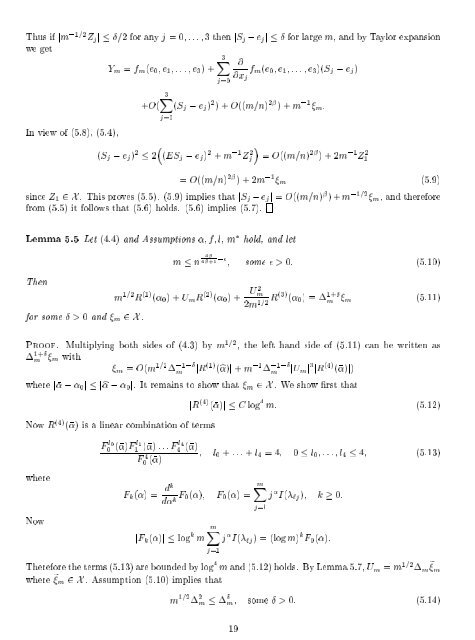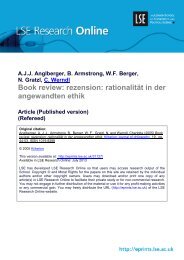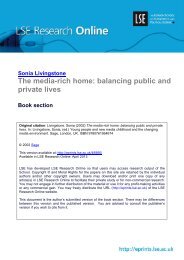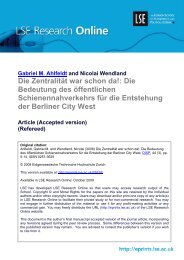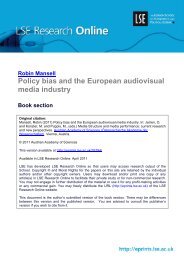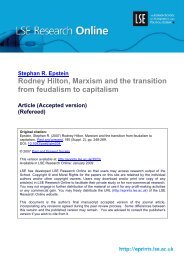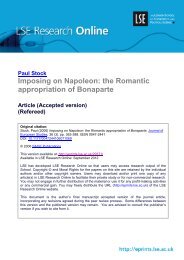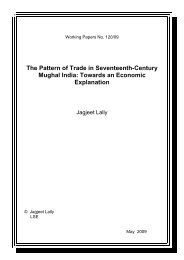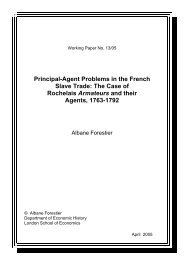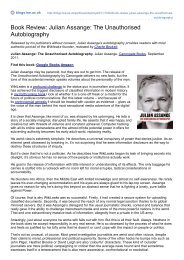Download (535Kb) - LSE Research Online - London School of ...
Download (535Kb) - LSE Research Online - London School of ...
Download (535Kb) - LSE Research Online - London School of ...
You also want an ePaper? Increase the reach of your titles
YUMPU automatically turns print PDFs into web optimized ePapers that Google loves.
Thus if jm ;1=2Zjj =2 foranyj =0:::3thenjSj ; ejj for large m, and by Taylor expansion<br />
we get<br />
3X @<br />
Ym = fm(e0e1:::e3)+ fm(e0e1:::e3)(Sj ; ej)<br />
@xj<br />
In view <strong>of</strong> (5.8), (5.4),<br />
(Sj ; ej) 2<br />
+O(<br />
3X<br />
j=0<br />
j=0<br />
(Sj ; ej) 2 )+O((m=n) 2 )+m ;1 m:<br />
2 (ESj ; ej) 2 + m ;1 Z 2<br />
j = O((m=n) 2 )+2m ;1 Z 2<br />
1<br />
= O((m=n) 2 )+2m ;1 m (5.9)<br />
since Z1 2X. This proves (5.5). (5.9) implies that jSj ; ejj = O((m=n) )+m ;1=2 m, and therefore<br />
from (5.5) it follows that (5.6) holds. (5.6) implies (5.7).<br />
Lemma 5.5 Let (4.4) and Assumptions f l m hold, and let<br />
Then<br />
for some >0 and m 2X.<br />
m n 4<br />
4 +1 ; some >0: (5.10)<br />
m 1=2 R (1) ( 0)+UmR (2) ( 0)+<br />
U 2 m<br />
2m 1=2 R(3) ( 0) = 1+<br />
m m (5.11)<br />
Pro<strong>of</strong>. Multiplying both sides <strong>of</strong> (4:3) by m1=2 , the left hand side <strong>of</strong> (5.11) can be written as<br />
m with<br />
1+<br />
m<br />
1=2 ;1;<br />
m = O(m m jR(1) ;1 ;1;<br />
(b)j + m m jUmj 3 jR (4) ( )j)<br />
where j ; 0j jb ; 0j. It remains to show that m 2X. We show rst that<br />
Now R (4) ( )isalinearcombination <strong>of</strong> terms<br />
where<br />
Now<br />
F l0<br />
0<br />
( )F l1<br />
1<br />
( ) :::Fl4<br />
4<br />
F 4<br />
0<br />
( )<br />
jR (4) ( )j C log 4 m: (5.12)<br />
( )<br />
l0 + :::+ l4 =4 0 l0:::l4 4 (5.13)<br />
Fk( )= dk<br />
d k F0( ) F0( )=<br />
jFk( )j log k m<br />
mX<br />
j=1<br />
mX<br />
j=l<br />
j I( `j) k 0:<br />
j I( `j) = (log m) k F0( ):<br />
Therefore the terms (5.13) are bounded bylog 4 m and (5.12) holds. By Lemma 5.7, Um = m 1=2 m e m<br />
where e m 2X. Assumption (5.10) implies that<br />
1=2 2<br />
m m m some >0: (5.14)<br />
19


